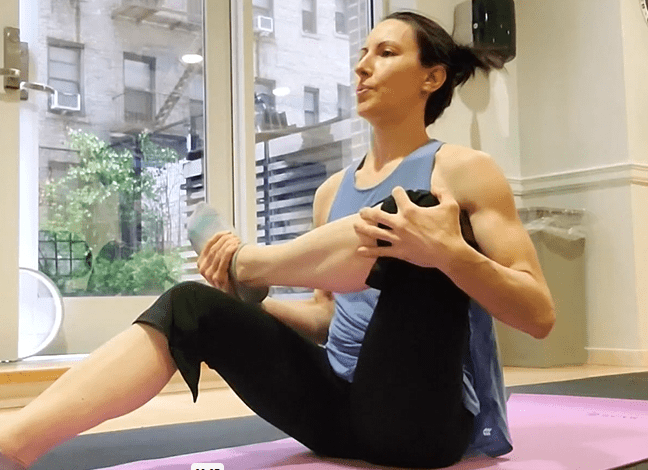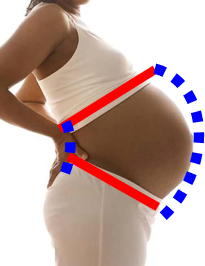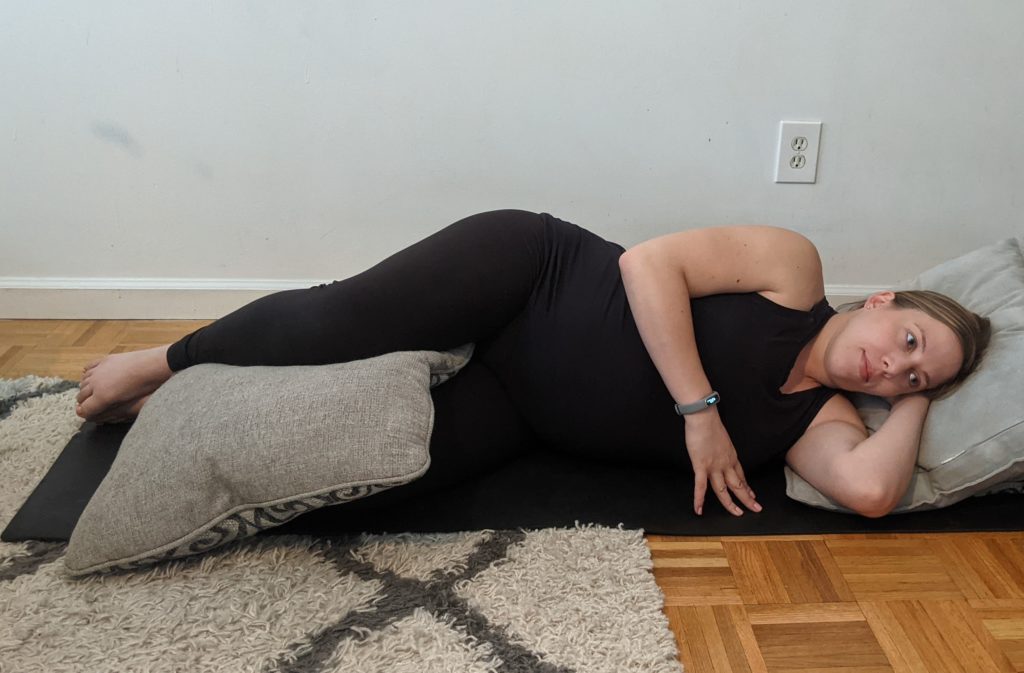Sciatica: Exercises to Focus On & Avoid

“My pregnancy was progressing well until the 4thth month, when I started experiencing intermittent, debilitating nerve pain in my left hip when walking. The pain was so bad that I didn’t know how I could get to the store, especially at the end of my pregnancy. This type of incident happened several times over the course of a few weeks but, after about a month, I never had any problems again. Very mysterious. I suspect my son found a cozy spot, located just in front of my lumbar spine, and slept very long.
– Carolyn Appel, Director of Education, PROnatal Fitness.
While there are many aches and pains that your pregnant body may experience as a result of weight gain, alignment changes, and other physiological changes, sciatica may be one of the worst.
Sciatica is no a medical diagnosis. Rather, it is the term used to describe irritation in the sciatic nerve. It can be experienced as numbness, pain, or tingling in the back of your hips and buttocks, and down each leg. It’s a pain usually felt on one side and can vary from dull and mild, to sharp and shooting.
Sciatica is sometimes confused with SI Joint Pain (another common pregnancy “butt pain”), but if you’re feeling numbness and pain radiating down your leg, it’s probably sciatica.
The good news is that, like the example above, the pain may be transient and only bother you for a limited period of time during pregnancy.
More good news: there are certainly things you can do to ease the pain. This will be the focus of this post. First, let’s start with a brief look at what causes sciatica so you can better understand some of the strategies we recommend to address it.
What Causes Sciatica
In this diagram, you can see that the sciatic nerve (in blue) exits the lumbar spine and travels down the back of the leg. Therefore, any “hooking” in its path can cause irritation. Some examples of things that can cause entrapment, or irritation, in the sciatic nerve are:
- Spinal misalignment (such as with a herniated disc in the lumbar spine)
- Another potential cause is due to an imbalance in the hip muscles. Muscles can become too tight from overuse and compress the nerve, which runs through it. Conversely, if the glute muscles are weak due to underuse, the piriformis – a deep hip rotator – can overcompensate and compress the sciatica nerve. This last reason is often referred to as piriformis syndrome.
The most common reason during pregnancy is anterior pelvic tilt from the growing belly. When the pelvis moves forward, it pulls the lumbar spine forward excessively low back arch, as you can see in the picture below. This can put pressure on the sciatic nerve.


Focus Exercises
To relieve sciatic nerve pain, you want to focus on the following two goals:
- Reduce pressure on structures that compress the nerve
- Strengthening the surrounding structures to increase pelvic stability.
Here are some useful exercises to focus on.
1. Focus on Neutral Alignment: OK, so this first one isn’t technically an “exercise,” but it is most important tip to focus on to reduce sciatic nerve pain. Poor spinal alignment plays a large role in the potential for nerve irritation. Therefore, you want to focus on “getting neutral” to restore better balance to the curves of your spine. Pay attention to entering your body pelvic neutral, as explained in the video.
2. 360° Breathing: We refer to this one as the #1 most effective core exercise. 360° Breathing has many benefits, but specifically related to sciatica, it helps strengthen your core from the inside out, which helps stabilize your hips and pelvis. While this demonstration is shown seated, this position may not feel good for your hips, so adjust as needed. You can try standing, on your side, on your hands and knees, or whatever position relieves your symptoms.
3. Cat Stretch: Posterior pelvic tilting (or tucking your pelvis under, as in the “cat” part of the cat-cow) can provide some temporarily relief by relieving pressure on the sciatic nerve. This stretch is a variation on the “cat-cow” stretch where you only do the part of the cat (tuck your pelvis under), then return to a neutral spine instead of going into “cow” (arching).
4. Seated Cradle Stretch: This is another feel-good stretch to take pressure off the sciatic nerve. Raise your leg only as far as you can to maintain neutral alignment (sitting tall).
5. Windshield Wiper with Fold: This is another good one to relieve pressure from the sciatic nerve. Hold one side for several breath cycles.
6. Back-lying Sciatic Nerve Floss: This technique is similar to stretching, but it helps to gently mobilize the nerve and get it to “get rid of.” Try this for a few repetitions. You don’t have to straighten your leg completely. Just reach your foot to the point where you feel a gentle stretch in the back of your leg.
7. Bridge (with optional knee squeeze): Remember the second goal of our sciatica exercises is to strengthen the surrounding muscles to increase pelvic stability. Your glutes help stabilize your pelvis, and this bridge exercise is a great way to target your glutes. For an added bonus, place a rolled up towel, slightly deflated ball, or yoga block between your knees and actively squeeze it while building your bridges — on the climb and down This helps strengthen your inner thighs (adductors), which can also reduce stress on your outer hips (remember overactive hips sometimes contribute to sciatica).
8. Incline Plank: Strengthening the front of your core can help lengthen your lumbar spine (key to relieving pressure on the sciatic nerve) while also helping you establish and strengthen the neutral pelvic position we discussed in #1. A plank can be a great exercise for this. Of course, depending on where you are in your pregnancy, you may need to change the whole board. The incline plank can be a good choice. The key to figuring out the right plank variation (and incline level) for you is that you should be able to do your plank 1) maintaining neutral alignment, and 2) without coning your belly.
9. Bird Dog: Like the incline plank, this is another great pregnancy-safe exercise that targets the muscles in the front of your core.
10. Sleep on the “uninjured side:” Well, like #1, our last point isn’t an “exercise” either, but it’s important to remember that you may be more comfortable sleeping on your “good” side. When sleeping on your side, place a pillow between your knees to keep your pelvis in a more neutral alignment. You can also try a warm compress o warm bath for temporary relief.


Exercises to Avoid
The exercises to avoid are very similar to what you are experiencing SI Joint Pain. This includes:
- Single Leg Lower Body Movements: Single-leg movements with weight such as lunges of any kind or step-ups/downs put your pelvis in a less stable position. In general, you want to keep your weight evenly spaced within two feet (think squats and bridges).
- Traditional cardio machines: Machines like the elliptical, Stairmaster, and treadmill promote single-leg activities, so it’s best to avoid them.
- (Be careful with) daily activities on one leg: Activities such as walking, climbing stairs, and getting on and off the ground are too activities on one leg. Of course, it’s not possible to completely avoid these activities, nor would we want you to. It’s important keep moving. Maybe you just want to limit it extended period of walking or climbing stairs when the pain is severe. Also, when getting off the ground, climb to the side that doesn’t hurt.
- Effect: When performing any type of impact activity (running, plyometrics, etc.), the forces of the impact travel through the body and can induce more pain. It’s best to focus on low-impact movements while you have symptoms.
- Any movement that causes pain: This should be an obvious one, but worth mentioning. Sometimes pain triggers are different for each individual, so try to pay attention to the activities that trigger pain for you, and avoid those.
Want More Help?
For effective prenatal workouts that will help you gain strength and relieve common pregnancy pains like sciatica, explore our pre and postnatal self-guided training programs. Or, for a more personalized approach, visit our Find a Coach page to work with one of our experts Pronatal Personal Trainers almost or find a PROnatal Certified Coach in your place.
Interested in Becoming PROnatal Certified?
Are you a fitness or health professional interested in coaching pre and postnatal clients? Explore our Pre & Postnatal Professional Education. We offer in-depth education to become Pronatal Certified for those seeking to specialize in training in this population, and a mini course for group fitness instructors which only requires basic knowledge.





